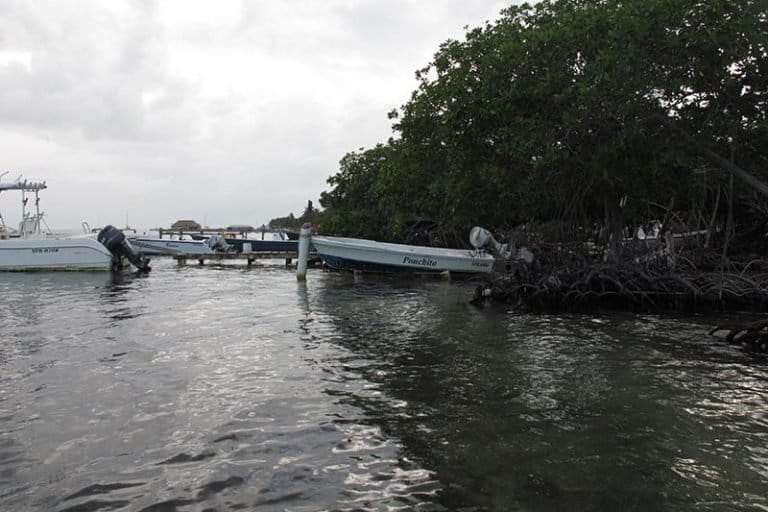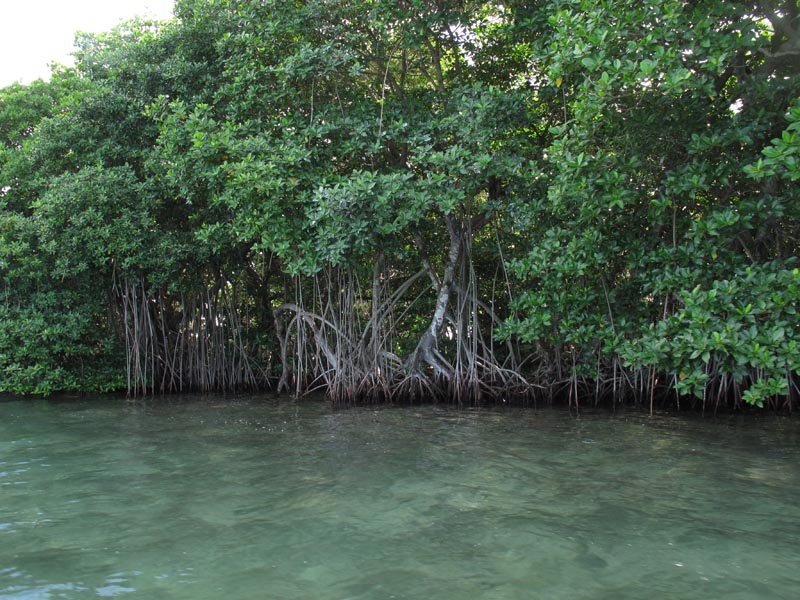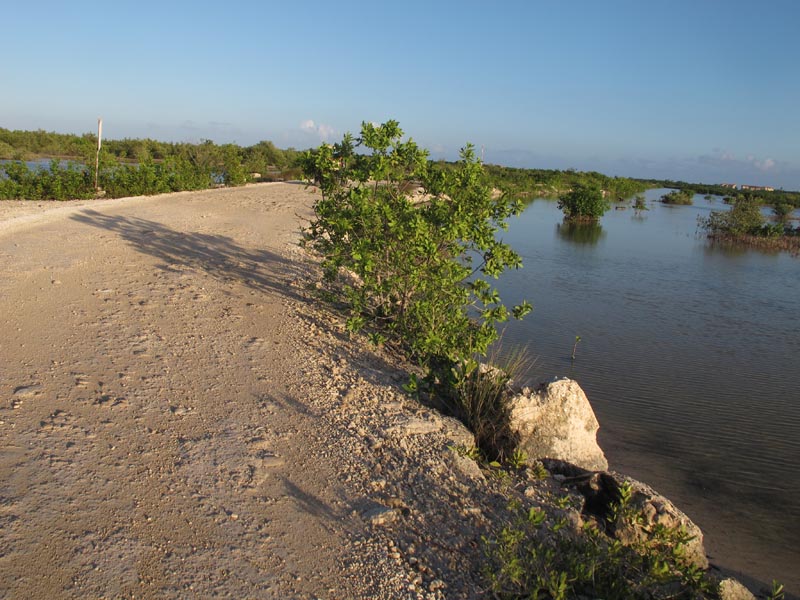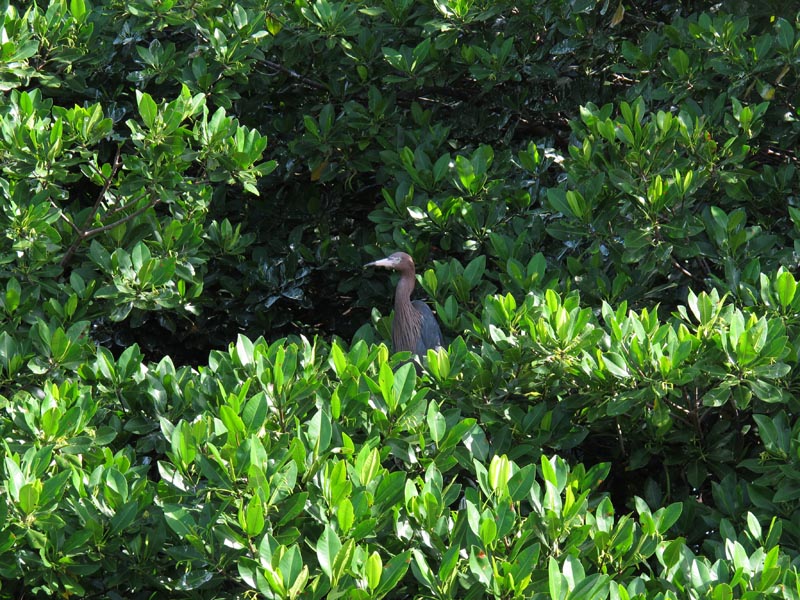- Towns like San Pedro depend on attractions like Hol Chan Marine Reserve to bring tourists but loss of mangroves on land is a threat to clean water and healthy reefs
- A number of business owners would like to see better mangrove protections and planning documents developed
- Up to one third of Belize citizens work in the tourism sector, more than agriculture
SAN PEDRO, Belize – Walking the shore of San Pedro provides a solid picture of the tension between natural resources and the economy in this, the top tourist town in coastal Belize. White coral sand gives way to several hundred feet of stunningly deep blue water out to where Caribbean waves strike the Mesoamerican Reef, the world’s second longest barrier reef, which stretches from Honduras in the south to its Mexican terminus to the north.
Just below swooping frigatebirds stands a phalanx of hotels, ranging from funky and low slung to sleek, new, and relatively tall. Bars, restaurants and dive shops elbow right up to the water’s edge, too, where one can sit in a plastic chair drinking local rum while dangling your feet in the warm tide at establishments with names like “Sandy Toes.”

But walk north along the beachfront just a little ways and your path is diverted away from the water by a wiry stand of mangrove trees growing in the gentle waves. This mangrove belongs to yet another open-air bar, La Choza, and reminds one of what this whole area once looked like.
“If I cut those trees, erosion will get our bar,” owner Luis Cabanas explained when asked. “The mangrove protected us from Hurricane Earl last year, the roof didn’t go.” Cabanas has been in San Pedro 28 years and remembers the beachfront at that time was a lot wilder, with mangroves marching right into the waves along much of it.
When asked if he keeps the mangrove trees for any other reasons, he added with a smile, “We like to give homes to the little fishes.”

Mangroves mean money
Located on the southern tip of Ambergris Caye just a quick water taxi ride from mainland Belize, sun worshippers and nature lovers jam the island town each winter. Its proximity to world class dive spots like Hol Chan Marine Reserve and The Blue Hole, in addition to mainstay tourist activities like parasailing, fishing, sea kayaking, reef tours via mask and snorkel, plus great restaurants, has built the popularity of this destination.
And the town benefits greatly from foreign dollars, as does much of the country: it’s estimated that one quarter to one third of the population of Belize is employed in the tourism sector, with eco-tourism making up a big slice of that pie.
But this economically important island, and numerous others scattered out among the Caribbean here, would not exist but for the mangroves, since they’ve always held shifting sand bars such as this one in place long enough for soil to form and make the place habitable. And beyond creating terrestrial habitat, mangroves are where most of the creatures who inhabit the nearby reefs and seagrass beds spend their first years, protected from predators among the trees’ close and tangled roots.

Fish grow in the trees
“Fish grow in the trees in Belize,” quipped fly-fishing guide Abner Marin when asked about the trees’ importance. His home is also on the waterfront here, just past La Choza. Out front, his flat-bottomed boat bobs, awaiting the next client seeking the hallowed bonefish, permit, or tarpon. Marin is typically booked every day during the winter high season, as are most of his fellow guides.
“Mangroves are the essence of our lives,” he continued, “especially for flats fishermen. The mangrove and the reef, it’s all connected. They create the cayes, stop erosion, filter waste, and yet we’re losing so many, so much fishing ground. When us guides complained, the mayor said ‘fish farther out.’”

While the mayor himself is said to have been a tour guide himself once, and more recently pushed for a marine protected area away on the other side of the island, Marin and other business owners here don’t feel the local government enforces rules that would protect the mangroves, and therefore everything their livelihoods depend upon.
One of these helped coalesce a resistance to the rampant, mangrove-clearing development trend. Chris Beaumont is a wiry ex-pat who moved here 17 years ago to teach windsurfing before starting a favorite business in town, the Belize Chocolate Company (which buys cacao from indigenous cooperatives on the mainland to make everything from bon bons to chocolate tea). Wearing a T-shirt emblazoned with the words “Peace, Love, and Chocolate,” he drove around inside a speculative new development that recently cut down a large area of mangroves north of San Pedro.

While dodging the other zooming golf carts, and signs admonishing people to get a permit before doing anything with their purchased plots, the new development otherwise appears fairly deserted. “Grand Belizean Estates” as it’s called is, so far, not very grand, being so far from town that no services exist, whether water, sewer, or electric, yet speculators have bought all 1,200 cleared lots in the hope that those services will come and allow them to build, ballooning the value of their investment.
Many mangrove areas like this are routinely lost, according to Beaumont, with developers buying a tract and clearing it without seeking a permit first. “It’s easier to ask for forgiveness than for permission, and then just pay the fine,” he said. While it’s illegal to cut mangroves without a permit, the fine is just $500 Belize ($250US), no matter the size of the lot, which does not discourage would-be developers.

Lack of a plan
“The island needs to develop, but there’s no master plan or any specific plan for development,” Beaumont said, “and owners of the bigger developments, and politicians, feel like mangroves are getting in the way. There’s no plan for what needs to be protected and conserved.”
In 2009, Beaumont and others sparked a movement that stopped a massive proposed development of 1,000 new homes just south of San Pedro called South Beach. “The whole island got together, held a march and said ‘this is a thing that can’t happen on the island.’” Only a portion of that mangrove area was cut before the saws were halted, and today it is slowly growing back as egrets, spoonbills, black necked stilts, and others wade around the sprouting stumps in search of a meal.

Attempts to ascertain San Pedro’s official position on mangrove development issues via phone and email were repeatedly dodged by the town’s deputy mayor, Gary Greif, despite agreeing to be interviewed.
But the head of another large official body in the area, Hol Chan Marine Reserve, Miguel Alamilla, responded that the situation for mangrove forests is tricky on the island, since most of them are in private developers’ hands, which leads to two kinds of harm.
“First they cut the mangrove, which is a wetland, then they have to dredge an area of seabed to fill it. So we are losing sea grass beds and benthic habitats in addition to those mangrove areas. So in response, we have been identifying and establishing new areas of mangroves within the marine reserve, especially those used by fishermen for sport fishing,” Alamilla said recently by phone from his office.

Is the review process for new developments adequate?
“I don’t think so,” Alamilla said. “The Environmental Impact Assessment process is flawed and is always on the developer’s side. Once you do an EIA and present it, it’s a done deal, there’s not enough time for review. Very few people would sit down and read one, it’s a large document that intimidates people. But when you read the information, a lot of it is nonsense. They take advantage of the fact that people won’t read them, that they don’t know all the fancy words.”
So Alamilla’s team has been condensing and translating information in EIAs for the public so that citizens can be better prepared for meetings and consultations about proposed developments. When asked if Ambergris Caye can accommodate more development, he says nobody knows, because there’s no plan for it.
“We have three draft management documents for the island. Draft. None of them have been completed,” Alamilla said with frustration. “So people don’t know what sustainable development is.”
In the vacuum, development is happening. “We provide protection for mangroves within the reserve,” he continued, “but for those outside, it’s a different story.”

Chocolatier Beaumont also wants a plan, and argues San Pedro could have both extensive mangroves and healthy, continual development, if the ethic were shifted and people got comfortable with the idea of living among the trees.
Gesturing at the nearby waterfront and wave-racked reef, he said, “The mayor has said that everyone wants that white sandy beach, with nothing in the way of the view, but what we should be selling is the diversity of the mangroves. Trim them! Make them look pretty! But let them also bring the birds and the fish in.”
Fishing guide Abner Marin calls mangroves the country’s most threatened tree, and talks of leading a campaign to change the national tree designation.
“Currently mahogany is our national tree, but for each one that’s cut, they plant more. With mangroves, when one is cut down, they put sand over it,” he said.
“If we kill the mangroves, we kill ourselves, ” he continued. “We can’t develop everything.”
FEEDBACK: Use this form to send a message to the author of this post.
Data citations:
- Giri C, Ochieng E, Tieszen LL, Zhu Z, Singh A, Loveland T, Masek J, Duke N (2011). Status and distribution of mangrove forests of the world using earth observation satellite data (version 1.3, updated by UNEP-WCMC). Global Ecology and Biogeography 20: 154-159. doi: 10.1111/j.1466-8238.2010.00584.x . Data URL: http://data.unep-wcmc.org/datasets/4
- Hansen, M. C., P. V. Potapov, R. Moore, M. Hancher, S. A. Turubanova, A. Tyukavina, D. Thau, S. V. Stehman, S. J. Goetz, T. R. Loveland, A. Kommareddy, A. Egorov, L. Chini, C. O. Justice, and J. R. G. Townshend. 2013. “High-Resolution Global Maps of 21st-Century Forest Cover Change.” Science 342 (15 November): 850–53. Data available on-line from: http://earthenginepartners.appspot.com/science-2013-global-forest. Accessed through Global Forest Watch on June 22, 2017. www.globalforestwatch.org.